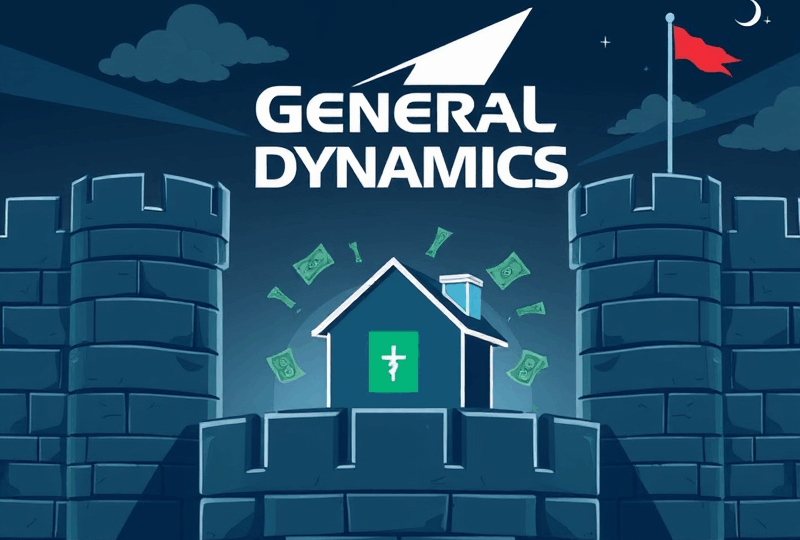
General Dynamics (GD): Is This Defense Stock a Fortress for Your Investments?

Hello, fellow investors and observers of global security! When you think about companies that build the ships, tanks, aircraft, and technology that nations rely on for defense, General Dynamics (GD) is undoubtedly one of the major players that comes to mind. With a long history and a diverse portfolio of products and services essential to national security, GD is often seen as a cornerstone of the defense industry. In times of global uncertainty or increased geopolitical tension, defense stocks like GD can sometimes be viewed as relatively stable investments, perhaps even a “fortress” for your portfolio. But is this perception accurate? Can a company tied so closely to government spending truly offer a reliable haven for your investments, and is it a compelling opportunity right now? You’re asking questions that delve into the unique dynamics of the defense sector and how its characteristics translate into investment potential and risk. The purpose of this article is to take a friendly, in-depth look at General Dynamics (GD) stock, exploring its business model, the factors that contribute to its stability (or lack thereof), the challenges it faces, and what you should consider when deciding if it fits into your investment strategy. Let’s explore whether this defense giant can indeed serve as a fortress for your investments.
General Dynamics: A Pillar of the Defense Industry
General Dynamics Corporation is one of the largest aerospace and defense companies in the world. It designs, manufactures, and maintains a wide range of systems and products for military and commercial customers. While often categorized simply as a “defense stock,” GD’s business is quite diversified across several key segments:
- Aerospace: This segment is primarily known for producing Gulfstream business jets, a leading brand in the corporate aviation market. While not strictly defense, it’s a significant part of GD’s revenue and is sensitive to the health of the global economy and corporate spending.
- Combat Systems: This segment produces land combat vehicles, including the Abrams tank, Stryker and LAV armored vehicles, as well as weapons systems and munitions. Its customers are primarily the U.S. Army and Marine Corps, and allied foreign governments.
- Marine Systems: This segment is a major builder of ships for the U.S. Navy, including submarines (like the Virginia class and Columbia class), destroyers (like the Arleigh Burke class), and other combat and support ships. Building complex naval vessels involves long-term, multi-year contracts.
- Technologies: This segment provides a range of information technology services, command and control systems, communication systems, and cyber security solutions to defense, intelligence, and government customers. This segment often involves service-based contracts and advanced technological development.
This diversified structure within the broader defense and aerospace sectors provides General Dynamics with exposure to different types of government spending and commercial markets, which can offer some balance to its overall business.
The “Fortress” Concept: Strengths of a Defense Stock
The idea of a defense stock like General Dynamics being a “fortress” for investments stems from several inherent characteristics of the defense industry, particularly for major contractors with long-standing government relationships:
- Stable Demand (Relative to Economic Cycles): While not entirely immune, defense spending is often less sensitive to short-term economic downturns compared to consumer spending or capital investment in many commercial industries. Governments tend to maintain defense budgets to ensure national security, even during recessions. This can provide a degree of stability to revenue and earnings that is attractive to investors seeking resilience.
- Long-Term Contracts: Major defense programs, such as building submarines or developing new combat vehicles, involve multi-year, often multi-decade, contracts with the government. These long-term contracts provide a predictable revenue stream and a substantial order backlog, offering visibility into future business that many commercial companies lack. The backlog acts as a buffer against short-term market fluctuations.
- High Barriers to Entry: The defense industry has extremely high barriers to entry. Developing complex military hardware requires immense R&D investment, highly specialized technical expertise, stringent security clearances, and navigating complex government procurement processes. Building trust and long-term relationships with government customers also takes decades. This limits the number of competitors and provides established players like GD with a strong competitive moat.
- Essential Products and Services: The products and services provided by General Dynamics – submarines, tanks, communication systems, cybersecurity – are essential for national defense and security. This makes the demand for their core offerings relatively inelastic; governments need these capabilities regardless of short-term economic conditions.
- Recurring Revenue from Services and Upgrades: Once a major system (like a tank or a ship) is sold, it requires ongoing maintenance, repair, upgrades, and parts throughout its lifespan, which can be decades long. This creates a significant stream of recurring, higher-margin revenue for defense contractors, adding another layer of stability to their business model.
- Global Geopolitical Environment: Unfortunately, global instability, geopolitical tensions, and conflicts often lead to increased defense spending by the U.S. and its allies. While not a desirable situation from a global perspective, it can translate into increased demand and a favorable environment for defense contractors.
These factors contribute to the perception that General Dynamics, as a major defense contractor, possesses characteristics that can make its stock a relatively stable and resilient investment, potentially acting as a “fortress” against broader market volatility.
Challenges and Risks to the “Fortress”
However, the “fortress” is not impenetrable, and General Dynamics faces specific challenges and risks that investors must consider:
- Government Budget Dependency: While defense spending is relatively stable compared to some sectors, it is ultimately dependent on government budgets and political priorities. Shifts in defense strategy, budget cuts (like sequestration in the past), or changes in administration can impact funding for specific programs or overall spending levels. A significant reduction in defense budgets would directly and negatively impact GD’s revenue and profitability.
- Program Risk: Major defense programs are complex, expensive, and often face delays, cost overruns, or technical challenges. Issues with a large program (like a new class of submarine or aircraft) can lead to financial penalties, reduced profitability, or even program cancellation, significantly impacting the company’s performance.
- Political and Policy Risk: Changes in foreign policy, alliances, or the approach to international conflicts can influence the types of defense systems that are prioritized and funded. Political scrutiny of defense spending and contractor performance is also a constant factor.
- Competition: While barriers to entry are high, GD operates in an oligopolistic market with a few other very large, capable competitors (like Lockheed Martin, Boeing Defense, Northrop Grumman, Raytheon Technologies). Competition for major contracts is intense and can impact pricing and win rates.
- Cybersecurity Threats: As a defense contractor handling highly sensitive information and developing advanced systems, GD is a prime target for cyber attacks. A significant data breach or cyber intrusion could have severe consequences for its reputation, operations, and security clearances.
- Supply Chain Disruptions: Like other manufacturers, GD relies on a complex network of suppliers. Disruptions in the supply chain, whether due to global events, geopolitical issues, or supplier financial problems, can impact production schedules and costs.
- Aerospace Segment Cyclicality: The Aerospace segment (Gulfstream business jets) is more sensitive to economic cycles than the defense segments. Demand for business jets tends to increase during economic expansions and decrease during downturns. This segment introduces a commercial cyclical element to GD’s overall business.
- International Sales Risks: Selling military equipment to foreign governments involves navigating complex export regulations, geopolitical relationships, and competition from other countries’ defense industries. International sales can be a source of growth but also come with political and currency risks.
These factors demonstrate that while GD benefits from the stability of the defense sector, it is not immune to risks, particularly those tied to government policy, program execution, and global events.
Financial Health and Valuation
When evaluating General Dynamics stock, investors typically look at several financial metrics. The company has a history of consistent revenue, strong profitability, and robust cash flow generation, supported by its long-term contracts and recurring service revenue. The size and trend of its order backlog are key indicators of future revenue visibility. Investors also often look at the company’s dividend history; GD has a strong track record of paying and consistently increasing its dividend, which is attractive to income-focused investors and can signal financial health and a commitment to returning value to shareholders. From a valuation perspective, investors compare metrics like the price-to-earnings (P/E) ratio, price-to-sales (P/S) ratio, and dividend yield to GD’s historical levels and to its peers in the defense industry. Defense stocks often trade at valuations that reflect their relative stability and predictability compared to more cyclical or high-growth sectors, but their valuations can still fluctuate based on market sentiment and outlook for defense spending.
The Defense Industry Landscape and Future Outlook
The broader defense industry is influenced by global geopolitical trends, technological advancements, and government budget priorities. Increased global tensions, competition between major powers, and the proliferation of new threats (like cyber warfare, hypersonics, and unmanned systems) are driving demand for modernization and new capabilities. This environment generally supports continued defense spending. General Dynamics’ diverse portfolio positions it to compete for contracts across various domains – land, sea, air, and cyber/technology. The future outlook for GD will depend on its ability to win major new programs, execute effectively on existing contracts, manage costs, innovate in key technological areas, and successfully navigate the political and budgetary landscape in the U.S. and key international markets. The long-term nature of defense procurement means that decisions made today can impact the company’s revenue for years or even decades to come.
Is GD Stock a “Fortress” or Just Resilient?
So, is General Dynamics (GD) stock truly a “fortress” for your investments? While no stock is a guaranteed fortress against all market downturns or risks, GD possesses characteristics that make it relatively resilient compared to many other companies. Its reliance on stable government defense spending, long-term contracts, high barriers to entry, and recurring service revenue provide a degree of stability and predictability that can be attractive, particularly during periods of economic uncertainty. It’s less susceptible to the immediate whims of consumer spending or the rapid shifts seen in some technology markets. However, it is still exposed to significant risks related to government budgets, program execution, political changes, and competition. A major cut in defense spending or issues with a key program could certainly impact the stock. Therefore, while perhaps not an impenetrable fortress, GD can be viewed as a relatively stable and resilient component within a diversified investment portfolio, particularly for investors seeking exposure to the defense sector and valuing dividend income and long-term contract visibility.
What Should You Do? Actionable Steps for Investors
If you are considering investing in General Dynamics (GD) stock, here are some actionable steps to take:
- Research General Dynamics’ Business Segments: Understand what each segment does and what drives its revenue. How diversified is the company?
- Analyze the Defense Budget Outlook: Pay attention to U.S. defense spending trends and priorities. Are budgets expected to increase, decrease, or remain stable? Which types of programs are being prioritized?
- Evaluate the Company’s Backlog: Look at the size and trend of GD’s order backlog. Does it provide strong revenue visibility?
- Review Financial Performance: Analyze trends in revenue, profitability, earnings per share, and cash flow over several years, considering economic and defense spending cycles.
- Assess Valuation and Dividend: Look at key valuation metrics (P/E, P/S) relative to peers and historical levels. Evaluate the dividend yield and the company’s track record of dividend growth.
- Understand Program Risks: While difficult for external investors, be aware that major programs carry execution risk. Follow news related to GD’s key programs.
- Consider Geopolitical Factors: How might global events and U.S. foreign policy influence demand for GD’s products?
- Assess Your Risk Tolerance and Portfolio Fit: Does a stock tied to defense spending fit with your investment philosophy and risk tolerance? How would it fit within your overall diversified portfolio?
- Focus on the Long Term: Defense contracts are long-term. If you invest, do so with a long-term perspective, understanding that the stock’s performance is tied to multi-year government spending cycles and global security trends.
Making an informed decision about GD requires understanding the unique characteristics of the defense industry and balancing the company’s inherent stability and long-term contract visibility against the risks of budget fluctuations, program execution, and political factors. It’s a stock that can serve as a resilient component in a diversified portfolio for investors who understand these dynamics.
General Dynamics: A Key Player in a Complex World
In conclusion, General Dynamics (GD) is a major defense and aerospace company with a diversified business model that benefits from the relatively stable demand for defense products and services, long-term government contracts, and high barriers to entry. These factors contribute to its reputation as a potentially resilient investment. However, it is not a true “fortress” immune to risk, facing challenges related to government budget cycles, program execution, political factors, and competition. While perhaps not poised for “massive growth” in the way a tech startup might be, GD offers exposure to a critical sector with long-term demand drivers tied to global security needs. For investors seeking stability, dividend income, and exposure to the defense industry within a diversified portfolio, GD warrants careful consideration. By doing your research, understanding the industry dynamics, and focusing on the long term, you can make a confident decision about whether General Dynamics has a place in your investment strategy. Wishing you insight, diligence, and success in your investing journey! 😊







